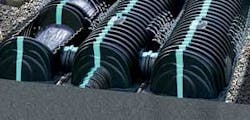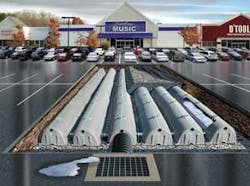By Fred Dotson
Every commercial development project must address stormwater management issues. As water quality and public health concerns continue to grow, so does the importance of proper stormwater control. Commercial land development and urbanization processes increase the number of impervious surfaces — such as roofs, parking lots, sidewalks and driveways — in the nation’s watersheds, resulting in a greater volume and rate of runoff as well as higher concentrations of pollutants in the runoff.
The Environmental Protection Agency requires every commercial building project to employ certain best management practices (BMPs) to control stormwater and protect water resources. One such practice comprises a subsurface retention/detention infiltration and storage chamber system that collects, stores, treats and releases stormwater.
The Rules
The Federal Water Pollution Act Amendment was implemented in 1972 to address the public’s growing awareness and concern over water pollution. Further amended in 1977, this law, now known as the Clean Water Act (CWA), aims to “restore and maintain the chemical, physical, and biological integrity of the Nation’s waters.” (33 U.S.C. 1251 et seq.) In relation to stormwater management, the CWA requires that a certain percentage of stormwater runoff be contained and treated on-site to prevent contamination of public water supplies and treatment facilities.
Underground Stormwater BMPs
Stormwater BMPs are methods determined by the EPA to be the most effective and practical means of reducing the quantity and improving the quality of stormwater runoff. They include above-ground BMPs such as wetlands, ponds and swales, and underground BMPs, such as retention tanks, tunnels, vaults, pipes and storage chambers. Underground storage chambers discussed here are typically made of high-density polyethylene (HDPE) and are capable of capturing high-volume runoff and infiltrating it into the ground or retaining it for later release. Thus, subsurface chambers can be used both to retain and detain stormwater on-site.
Retention and detention systems are two distinct methodologies typically used to control stormwater, even though the terms are sometimes used interchangeably in stormwater discussions. Retention is the process through which stormwater is stored without subsequent surface discharge. In underground retention systems, the chambers capture, filter and hold the stormwater until it is infiltrated into the ground. In detention processes, runoff is only temporarily stored until it is cast out to an off-site area, such as a storm drain, pond, or wetland. A detention system is usually implemented if local municipality regulations or concerns for watershed pollution prohibit infiltration practices at a commercial building site. As a rule, a subsurface detention system features all the same components as the retention system, with the addition of a pond liner and back-end filter. A pond liner prevents the stormwater from infiltrating into the ground, and a back-end filter treats the runoff before it is released off-site.
Some manufacturers have designed their own header systems that may be used instead of conventional pipe manifolds. By eliminating an external manifold, the side portal internal manifold feature shown here reduces material cost and land area required.
null
Benefits & Limitations
While above-surface BMPs have long served as effective stormwater management solutions, ever-increasing land prices — especially in urban areas — demand more efficient use of space. This factor, along with maintenance expenses, liability issues and public safety concerns (including the provision of standing water that could lead to the spread of West Nile Virus), often makes above-ground treatment solutions less attractive to urban developers.
In addition to freeing land for further development, underground chamber systems are cost-effective to install and maintain. The individual components are lightweight, stockpile easily, and do not require heavy installation equipment to maneuver. The systems are often made with interlocking connections, which afford fast and straightforward installation. The HDPE material used in many chambers is corrosion-resistant and durable, thereby extending the potential longevity of the system.
An important feature of a subsurface chamber system is that it removes a high percentage of phosphorus, nitrogen, lead, zinc, suspended solids and organic compounds from the runoff via infiltration. Additionally, underground chambers:
- Allow for more controlled infiltration into the ground.
- Replenish the surrounding soil and aquifer.
- Avoid redirecting stormwater to a watercourse and potentially overloading or polluting the natural surroundings and resources.
When discussing subsurface chamber systems, it is important to note that they might not be appropriate in areas where groundwater is a primary source of drinking water due to the potential for contaminant migration if pretreatment has not been employed. Additional concerns might include limited performance in areas with poorly permeable soil, such as clay, and reduced infiltration rate due to excessive sediment accumulation.
Components
A typical underground stormwater system includes the following elements: the inlet, water quality device, conveyance device and storage chambers. The process begins with runoff entering a collective device, ordinarily from a basin inlet structure. From the inlet, the stormwater then passes through a preventative maintenance device connected to the front end of the system. Examples of the water quality unit include a swirl settling device or a unit that may contain filter media such as sand, organic material, carbon or a membrane to remove debris and silt from the runoff.
Stormwater then enters a manifold system that conveys the runoff to the bed of stormwater chambers. A conventional manifold consists of a pipe and fitting configuration; however, some chamber manufacturers have also created their own manifolds unique to their products.
The stormwater chambers are dome-shaped, open-bottom, corrugated units with perforated sidewalls that store the stormwater. They often come in a variety of sizes to accommodate varying site conditions such as high groundwater or the need for condensed, high-volume storage.
The underground stormwater system may be used in residential and commercial applications as allowed by local municipality regulations. Chambers may be installed singularly or in series to control stormwater. Some systems, such as small residential applications, require only one or two chambers, while others — such as a large commercial site development — may require thousands of units.
null
Design Considerations and Flexibility
Many factors come into play when a stormwater management system is selected, including federal, state and local regulations, the site’s terrain and layout, budget, maintenance requirements and environmental impact considerations. Three key areas of focus that help guide the selection of the right subsurface stormwater system are depth, available area and required volume. These factors help determine the type and capacity of a system’s components, including the required filters, manifold systems and storage chambers.
- Depth: How far below the surface will the system need to be installed? This will be determined by a construction site’s terrain, including the amount of rock, the earth’s natural ledge and the level of groundwater found on-site.
- Area: How much land is available for a stormwater management system? The size and layout of a project site will determine the size of the system and its configuration. Generally, a chamber system can be designed in multiple ways to accommodate a particular project’s needs. For example, the chambers can be installed in one or more beds; in a single layer or multiple layers; distributed throughout the site; or installed in long perimeter runs near the property lines.
- Volume: What is the expected amount of runoff the system will have to handle? This consideration will determine the number and size of the chambers.
Conclusion
Subsurface chamber systems have a number of advantages that make them an appealing stormwater management solution. They offer significant groundwater recharge in areas with a high percentage of impervious surfaces, satisfy the EPA’s Clean Water Act requirements, and remove a high percentage of pollutants from runoff. These chambers have exceptional shipping and stockpiling capabilities, offer a straightforward, cost-effective installation and require minimum maintenance. In addition, their installation underground allows for the maximum development of available land — a vital factor in urban environments. uwm
About the Author:
Fred Dotson serves as vice president of CULTEC Inc. (Brookfield, CT), a national manufacturer of plastic chambers for stormwater and septic applications as well as header and stormwater filter systems. Dotson has nearly a decade of experience in the stormwater industry, providing technical support to design engineers as well as performing pre-installation consultations.




